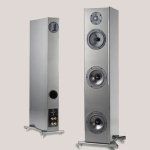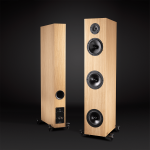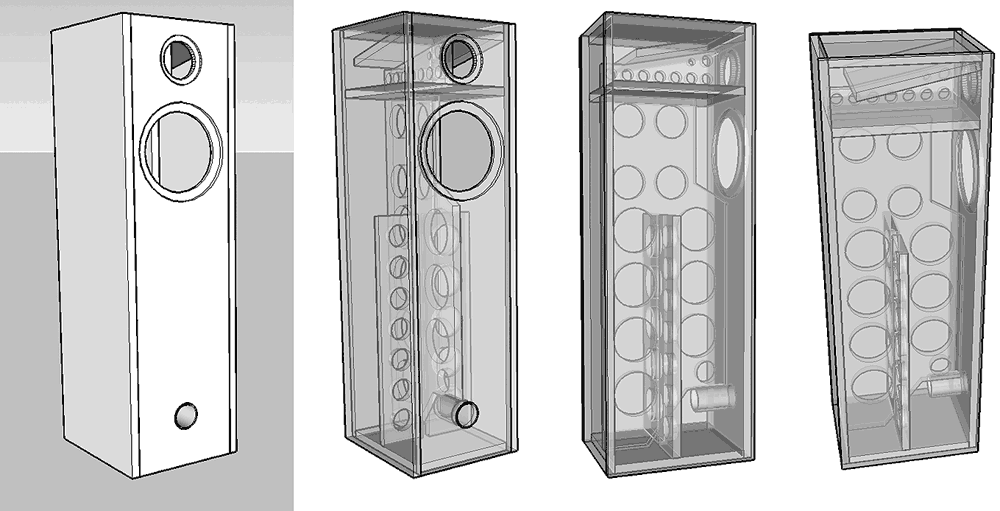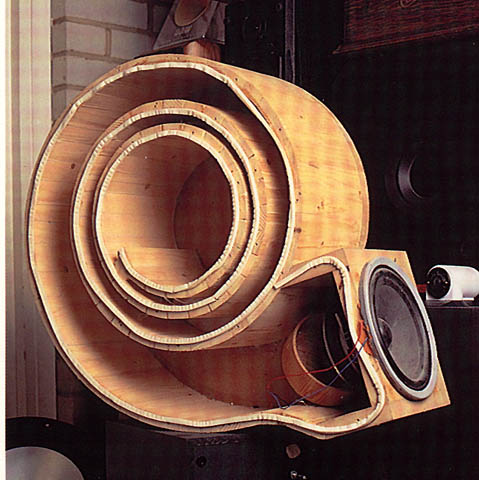I've recently heard a pair of speakers at an audio show named the Endeavor E3 from VonShweikert, and despite being a smaller pair of 3 way floor standing speakers, sounded phenomenal. Perhaps the best I've heard considering the size. Being an avid engineering enthusiast, I figured to try and de cypher some neat design choices that was used when designing this speaker, and I thought to maybe get some expert input from you all as well.
Two models available: standard and special edition.
Standard:
Dayton audio reference woofer RS180
Hivi L6 kevlar woofer
Scan Speak R2604 ring radiator tweeter
Special edition:
Dayton audio reference woofer RS180
Hivi L6 kevlar woofer
Scan Speak D3004 beryllium tweeter
Rear mounted Fountek Cd3.0 ribbon tweeter
Crossovers:
modified 4th-order linkwitz-riley with zobel conjugates to ensure correct phase and time alignment-with extremely wide horizontal and vertical off axis accuracy.
Frequency Response: 29Hz to 22kHz (+/-2dB)
Weight: 95 lbs per cabinet
Dimensions: 44" x 9" x 15" (HxWxD) Tapers down to 5" width at the back.
Enclosure design:
Here's where it gets creative. The bass is said to be loaded in a 4th order Butterworth modified "tuned" aperiodic vent design, critically damped to Q=0.7.
The midrange is said to be loaded in a tapered transmission line to avoid standing waves and rear reflections to ensure accurate midrange.
Total cabinet thickness: 2.75"
I'm genuinely interested in learning how such bass is achieved in such a small design. Modeling these drivers in software using just a normal vent means the enclosure must be 2-3 times the volume in order to achieve a -3 of 28hz.
Two models available: standard and special edition.
Standard:
Dayton audio reference woofer RS180
Hivi L6 kevlar woofer
Scan Speak R2604 ring radiator tweeter
Special edition:
Dayton audio reference woofer RS180
Hivi L6 kevlar woofer
Scan Speak D3004 beryllium tweeter
Rear mounted Fountek Cd3.0 ribbon tweeter
Crossovers:
modified 4th-order linkwitz-riley with zobel conjugates to ensure correct phase and time alignment-with extremely wide horizontal and vertical off axis accuracy.
Frequency Response: 29Hz to 22kHz (+/-2dB)
Weight: 95 lbs per cabinet
Dimensions: 44" x 9" x 15" (HxWxD) Tapers down to 5" width at the back.
Enclosure design:
Here's where it gets creative. The bass is said to be loaded in a 4th order Butterworth modified "tuned" aperiodic vent design, critically damped to Q=0.7.
The midrange is said to be loaded in a tapered transmission line to avoid standing waves and rear reflections to ensure accurate midrange.
Total cabinet thickness: 2.75"
I'm genuinely interested in learning how such bass is achieved in such a small design. Modeling these drivers in software using just a normal vent means the enclosure must be 2-3 times the volume in order to achieve a -3 of 28hz.
Attachments
The bass is said to be loaded in a 4th order Butterworth modified "tuned" aperiodic vent design, critically damped to Q=0.7.
Bet that is marketing gooblegook for something much simpler.
Strange driver spacing. From the outside looks like an ML-TL where they ar efightinh the quarterwave..
dave
Do you know this is the woofer, or are you assuming based on looks from the front and what others have speculated?Dayton audio reference woofer RS180
https://www.vonschweikert.com/endeavor-e-3-mkii
"175mm anodized aluminum coned woofers. Double-stacked magnets provide fast transient response and great dynamics. Faraday ring-type motor/voice coil"
“The midrange is said to be loaded in a tapered transmission line to avoid standing waves and rear reflections to ensure accurate midrange.”
I don’t see the port for the midrange t-line. I’m guessing there’s a traffic cone in there or maybe a flower pot. A tapered enclosure isn’t a transmission line. It might be a labyrinth?
I don’t see the port for the midrange t-line. I’m guessing there’s a traffic cone in there or maybe a flower pot. A tapered enclosure isn’t a transmission line. It might be a labyrinth?
A wedge shaped enclosure is called a transmission line?
Nautilus is the "flagship” of half-wave transmission lines. I was taught the trick shown in the above in the early 70s.
A pipe closed at one end, open at the other is a quarterwave resonator, both ends closed or both ends open is a halfwave resonator.
dave
Last edited:
System in OP, Drivers speak for themselves
sure sounds fine, for the most part.
Tweeter spacing is mounted
to far far away.
Woofer spacing is far far far far
33 zillion miles apart.
= Nonsense
Centered tweeter for " looks"
Somethin I have done as well.
Lately I am just over it finally.
I dont mind off centered drivers anymore
to actually achieve a flatter response.
Ironically allows center to center
to be tighter with woofer/midrange.
So more benefits to just ignore
"looks"
sure sounds fine, for the most part.
Tweeter spacing is mounted
to far far away.
Woofer spacing is far far far far
33 zillion miles apart.
= Nonsense
Centered tweeter for " looks"
Somethin I have done as well.
Lately I am just over it finally.
I dont mind off centered drivers anymore
to actually achieve a flatter response.
Ironically allows center to center
to be tighter with woofer/midrange.
So more benefits to just ignore
"looks"
Just say generic assumption is below 300 HzI'm genuinely interested in learning how such bass is achieved in such a small design. Modeling these drivers in software using just a normal vent means the enclosure must be 2-3 times the volume in order to achieve a -3 of 28hz.
expect 6 dB losses to bass and resulting baffle step. For any speaker.
It is a skinny magical baffle so expect that to happen even higher
closer to 400 to 500 Hz
So adding a second woofer crossed over lower
will help flatten and reduce those losses.
Likewise just a second woofer,
Is adding linear excursion/ Xmax dedicated to bass
frequency. So regardless of magical
port/ fart tubes.
Real bass is more woofer and the usual 3 to 8 dB
added from normal EQ.
A woofer with low resonant frequency
helps guarantee actual electrical/ mechanical production
of bass frequencies.
So RS180 is rather respectable as well in that department
being around 35 Hz resonant frequency (Fs)
It is a low distortion motor and makes good bass for a 7"
x2 even more glory.
Transmission line has a speaker at one end and an opening at the other. This had been the definition for 59 years. “In 1965 Arthur R. Bailey, an engineer at the University of Bradford, published an article in Wireless World describing the design of a loudspeaker he called “non-resonant”. Unlike the acoustic labyrinth, only lined, the opening faced the same plane as the loudspeaker. This configuration was the first referred to as a transmission line.“ The line as defined is open.Nautlus is the :flagship” of half-waventransmission lkines. I was taught the trick shown in the above in the early 70s.
A pipeclosed at one end cklosed at the other is a quarterwve resonator, both ends closed or both ends open is a halfwave resonator.
dave
There are closed pipes and open pipes, both operate according to physics. Really the only difference in closed or open pipe of the same length is an octave. This gets complicated when you consider the continuum of closed to open enclosures. Is a one cubic foot enclosure a transmission line? A short one, but I guess it can be thought of as a t-line. So, shape matters. The definitions seem arbitrary and incorrect, my understanding is a t-line has one open end. Maybe the terminology should change?
Thought it was just a brace for mid chamber.
Slanted board would just keep distances unequal.
Helpful and simple in more ways than one.
Always enjoy Planet10's designs
Either way port mounted low in a tower
will behave more like a TL line.
So good design approach is just model as TL.
So error compensation and resonance is more accounted
for in the model. No surprises as if just modeled as a reflex.
Which would need correct port end error compensation and have resonance
unaccounted for in a simple model.
Slanted board would just keep distances unequal.
Helpful and simple in more ways than one.
Always enjoy Planet10's designs
Either way port mounted low in a tower
will behave more like a TL line.
So good design approach is just model as TL.
So error compensation and resonance is more accounted
for in the model. No surprises as if just modeled as a reflex.
Which would need correct port end error compensation and have resonance
unaccounted for in a simple model.
Transmission line has a speaker at one end and an opening at the other.
An end loaded quarter-wve TL. A small subset of transmission lines.
I see you are stuck on the Bailey. He was not first.
Do you also think Bailey’s line was non-resonant?
dave
Thanks for the replies everyone. Its greatly appreciated. From what I gathered and saw from brief images of the enclosures with no drivers in them, the midrange has a sloped rear wall, which I assume is called a tapered transmission line in this regard even though it is sealed.
In terms of the woofer loading, I'm still a bit lost on how 30hz is achieved in such small cabinet, even if one woofer is crossed over lower. The company claims that a transmission line and labyrinth are two different things. Here's a quote:
In terms of the woofer loading, I'm still a bit lost on how 30hz is achieved in such small cabinet, even if one woofer is crossed over lower. The company claims that a transmission line and labyrinth are two different things. Here's a quote:
A transmission line is a box with internal compartments stuffed with damping material employed for nonresonant bass tuning. You can stuff the cabinet with Dacron, foam rubber, or fiberglass. Dacron is easiest to remove or add, so that’s what we use. Note that the terms transmission line and labyrinth are sometimes confused with each other. A transmission line is not necessarily constructed as a long tunnel (the labyrinth), and a labyrinth can sound boomy if it is not properly stuffed with an absorptive material, behaving more as a bass-reflex design. The way to determine whether a speaker is indeed a transmission line is to examine the impedance peaks of the cabinet and woofer. If you see two different peaks in the impedance measurement, you are seeing the resonance of the woofer and the resonance of the cabinet -- that is the sign of a bass-reflex cabinet design. Correctly designed transmission-line cabinets have only one impedance peak, occurring at the woofer’s free-air tuning frequency. The cabinet resonance will be damped by the stuffing material, which in turn eliminates the second of the impedance peaks
No actually, I was surprised at the claim of it being non-resonant. Every loudspeaker is resonant. Also, the rest of his paper talked about resonance. I guess his design is less resonant than a traditional BR design.
So, closed end pipes and open end pipes are both ‘transmission lines’. (I never liked that name either.) I’m not stuck on Bailey as much as I’m ignorant, I’m learning a lot about different designs lately. I guess my rub is with the name transmission line, what would a closed pipe transmit? It appears the Nautilus has a different purpose (works in a different way, as a wideband filter?) than the open ended T-lines. I imagine you could make a fractal branched closed T-line? The octopus or kraken?
So, closed end pipes and open end pipes are both ‘transmission lines’. (I never liked that name either.) I’m not stuck on Bailey as much as I’m ignorant, I’m learning a lot about different designs lately. I guess my rub is with the name transmission line, what would a closed pipe transmit? It appears the Nautilus has a different purpose (works in a different way, as a wideband filter?) than the open ended T-lines. I imagine you could make a fractal branched closed T-line? The octopus or kraken?
Maybe the second woofer has a second order high pass filter to raise output below resonance? Then tune the box low? It’s pretty much impossible to passively increase output below resonance, maybe they are filtering out higher frequencies above fs?Thanks for the replies everyone. Its greatly appreciated. From what I gathered and saw from brief images of the enclosures with no drivers in them, the midrange has a sloped rear wall, which I assume is called a tapered transmission line in this regard even though it is sealed.
In terms of the woofer loading, I'm still a bit lost on how 30hz is achieved in such small cabinet, even if one woofer is crossed over lower. The company claims that a transmission line and labyrinth are two different things. Here's a quote:
Not a newcomer...
https://www.audioholics.com/tower-speaker-reviews/endeavor-audio-e-3-mk2
https://www.audioholics.com/tower-speaker-reviews/endeavor-audio-e-3-mk2
The company claims that a transmission line and labyrinth are two different things
The design space opened up by the proper TL/quarterwave modelers from Martin King (MJK) and George Augspurger in 1999, has greatly expanded the scope of the term transmission line.
It has become a squishy term, used specifically for designs evolved from the Bailey/Radford/IMF theme, and in a much broader sense TL = quarter-wave resonator. And then we have particular names for flavours of TLs, for instance ML-TLs, and ML-Voigts (it was shown, thru MJK modeling, that all Voigts benefit GREATLY by being Mass Loaded).
Horns usually get called that even thou they are part of the greater quarterwave design space and we could stretch the term TL to cover horns, but we usually don’t.
A Voigt is the point where designs more tranditionally called TLs meet traditional Back Loaded Horns. It is easy to call a Voigt (ML-Voigt) either a TL or a Horn. I will note that the BIB, a stretched out Voigt that requires a corner to finish the loading is even more “Horn-like”.
And then there are those who will adamantly argue that the only thing that qualifies as a TL, is a box that satisfies the critria laid out in the title of the seminal Wireless World article, “A Non-Resonant Enclosure Design”. They obviously did not pay attention to what he actually built. It is clearly a quarterwave resonator.
If one takes a TL (of any sort) and makes it long enuff and damped enuff to become aperiodic it then becomes a Non-Resonant Enclosure Design = Labyrinth
The company claims
They seem to have a strange definition of a TL, and say things in that paragraph that are untrue and even contradict. Marketing gooblegook.
for reference (anecdote: scanned from the Blue Binder i got from KEF loaded up with aricles like these);
Bailey 1: http://p10hifi.net/planet10/TLS/downloads/Bailey_TLs_1.pdf
Bailet 2: http://p10hifi.net/planet10/TLS/downloads/Bailey_TLs_2.pdf
Letters: http://p10hifi.net/planet10/TLS/downloads/bailey_letters.pdf
And Onley’s original 1937 article that predates Bailey: http://www.t-linespeakers.org/download/Onley-acoustic-labyrinth.pdf
Remember, these are the alike to the little shrew-like mammals that survived the dinosaurs and became homo sapien (if we may be so bold as to suggest that the entire space has matured [quite unlikely])
Now all that can be kinda confusing. MJK in particular showed that there is a continuum of designs that morph from sealed to reflex thru (traditional) pipes/TLs, Voigts and Horns. There are no real hard & fast lines. Eviolution in action.
This document takes a single driver and illustrates some of the desigh spectrum. Relex>Hybrid>ML-TL-Voigt loaded by the floor). http://p10hifi.net/FAL/downloads/Fountek-Five-planset-030412.pdf
dave
Every loudspeaker is resonant.
Unless it is aperiodic. Not as easy to do as it is to say.
dave
- Home
- Loudspeakers
- Multi-Way
- Unique design of the Endeavor-E3 speaker



